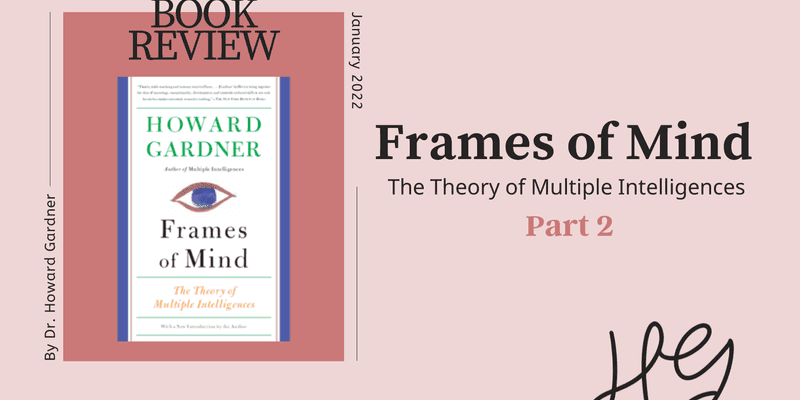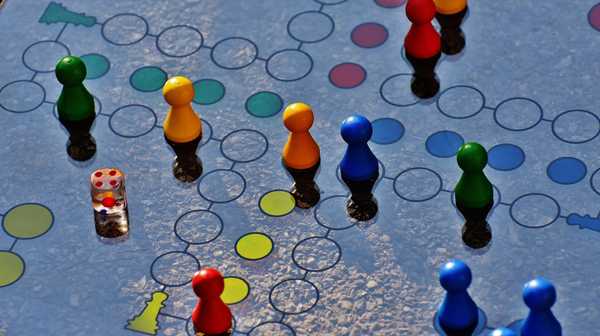
Exploring Multiple Intelligences: A Review of Frames of Mind by Dr. Howard Gardner – Part 2
February 17, 2022
In the first part of this article, we discussed the origins and emergence of the theory of multiple intelligences, the types of intelligences according to Dr. Howard Gardner, the reasons for identifying and understanding these types of intelligence, and how they can help identify and develop individuals’ hidden potentials.
In this second and final part, we will explore these relationships further and continue reading about the theory of multiple intelligences. We will also learn about internal and external sources of intelligence. Finally, we will look at Gardner’s suggestions for establishing scientific frameworks to measure individual intelligence (specifically in students) and how these measurements can improve the educational process.

Using Neuroscience to Understand Cognitive Traits
As we mentioned earlier, a stimulating environment has the greatest impact on enabling individuals to reach the highest levels of proficiency in areas that match their genetic traits. However, it is theoretically impossible to separate genetic traits from those acquired environmentally.
Therefore, neuroscience is often used to explain and understand cognitive traits. Fortunately, there are two principles from neuroscience that can help us understand these traits: canalization and plasticity.
The concept of canalization, proposed by British biologist Conrad Waddington in the late 1940s, simply means the tendency of organic systems to follow specific developmental paths. For example, the development of the human nervous system is remarkably predictable: cells first appear in the neural tube of the embryo, then gradually move towards the areas forming the brain and spinal cord to become part of it.
Plasticity, on the other hand, a concept developed by Polish neuroscientist Jerzy Konorski, describes the brain’s ability to be shaped by a wide range of environments. For example, regarding languages, the brain has the flexibility to adapt. If the left hemisphere of a child’s brain is removed in their first year, they will still be able to learn languages and speak fluently later on.
However, for an adult who undergoes the same procedure, it will be very difficult to speak and construct sentences for the rest of their life, even if they were fluent in several languages before the surgery.
Here lies the importance of the theory of multiple intelligences, as it allows societies to focus on the brain’s flexibility in young children and use it to design the educational process.
External Intelligences
Linguistic Intelligence involves a high awareness of language and its features.
Poets are the best example of individuals with high linguistic intelligence. Poetry is not just about combining similar words and syllables; it also involves the harmony and sound of words, making poems smooth and pleasant to listen to.
But it’s not just poetry that defines linguistic intelligence. Eloquence – the ability to use words in a powerful and convincing way to persuade others, change their opinions, or inspire them to take action – is another example, as seen in political leaders.
For most individuals, linguistic abilities are centred in the left hemisphere of the brain. Therefore, any damage to certain areas in this part of the brain can affect linguistic abilities.
For example, damage to Broca’s area – located in the frontal lobe at the front of the brain – can result in Broca’s aphasia, which significantly impairs the ability to speak and write, and understand spoken and written language. Even after treating the underlying cause, patients often need to relearn language skills and communication methods.
Musical Intelligence involves sensitivity to the characteristics of sounds.
Musical intelligence is linked to auditory and verbal abilities. Individuals with high musical intelligence can understand the properties of rhythms and reproduce them accurately.
Studies have shown that most people have some level of this intelligence, allowing them to distinguish melodies and identify good from bad music, as well as create and compose new harmonious sounds – even if they are simple.
Although music is similar to languages in terms of structure and reliance on sounds, musical intelligence is different from linguistic intelligence because the brain processes and stores musical compositions differently than it does words.
To prove this, British psychologist Diana Deutsch conducted tests where participants listened to a series of melodies and were asked to remember them. Then, she played different melodies and asked if they had heard them before. The error rate in remembering melodies exceeded 40%.
Conversely, when listening to sounds containing verbal components – numbers or words – the error rate dropped to just 2%.
Logical-Mathematical Intelligence revolves around abstract logic.
This type of intelligence begins with interacting with the world of objects and gradually evolves into abstract worlds of logic and science.
When it comes to mathematics, memory strength is not a crucial feature for mathematicians. Instead, their ability to understand logical connections between mathematical problems and grasp their general meaning is more important.
Mathematics is similar to poetry or painting, as all three focus on patterns, connections, and ideas rather than languages or sounds.
Spatial Intelligence is used for visualisation and orientation.
This intelligence involves the ability to accurately perceive the visual world and transform, modify, or recreate that perception, even if the visual stimulus is no longer present.
Although perception is strongly linked to visual understanding, spatial intelligence can function independently of the ability to see. This means that even blind individuals can possess exceptional spatial intelligence.
Those with high spatial intelligence can navigate their way, whether in a small room or in the middle of the ocean. This intelligence also provides a great sensitivity to fine details and characteristics in visual presentations, such as paintings, sculptures, and even architectural structures.
In fact, spatial intelligence can be used in a more abstract manner, such as drawing connections between different fields that may not appear related at first glance.
For example, chemist John Dalton visualised atoms as miniature solar systems, combining concepts from both chemistry and astronomy.
Masterful Use of the Body Shows Bodily-Kinesthetic Intelligence
Although many people do not associate physical activities and skills with intelligence, this is not true at all.
This misconception stems from the traditional association of intelligence with the mind and logic alone, as suggested by single intelligence theories.
However, upon closer examination, we notice that many precise tasks also involve physical activity. For example, a surgeon performing a very delicate operation relies not only on theoretical surgical knowledge but also on the precise movements of their hands, which are crucial for the success of the surgery.
Therefore, it is incorrect to claim that the brain does not play a role in physical movement. On the contrary, the brain helps improve, redirect, and adapt physical behaviour to better serve individual goals. The brain and body constantly communicate to execute many fine motor tasks.
Internal Intelligences
Personal Intelligence focuses on understanding oneself and others.
Internal personal intelligence involves an individual’s ability to connect with their inner thoughts, feelings, and emotions.
In contrast, external personal intelligence revolves around understanding others, specifically their moods, mental states, motivations, and intentions.
Both types of intelligence are located in the frontal lobes of the brain, where sensory information and limbic system data merge. This is where an individual’s perceptions of themselves or others combine with information related to their emotional state.
The Need to Develop Educational Systems to Reflect the Theory of Multiple Intelligences
If you wanted to teach someone computer programming, what intelligences would you use? Most people would choose the most obvious answer: logical-mathematical intelligence. Some might say linguistic intelligence is also important, as programming involves learning programming languages.
But what if we said that musical intelligence is also important for learning programming? By teaching the student to link algorithms and code snippets to form a coherent and effective program.
What if we said that spatial abilities – related to spatial intelligence – can also help teach programming effectively? This can be done by starting with diagrams like UML, flowcharts, and use cases.
For individuals with high personal intelligence, they could be taught through group work (like coding boot camps) or pair programming.
These examples show that although some intelligences are better suited for certain tasks, making the educational process more flexible by considering the different types of intelligences can make teaching methods more effective.
The author believes that the first step in applying the theory of multiple intelligences in education is to develop a more accurate intelligence test – or rather a set of tests. Intelligence should be assessed at different ages and monitored throughout students’ development. Early testing of children’s intelligences can help them advance quickly in areas where they are particularly skilled and receive support in areas where they struggle.
The second step, according to the author, is for educational institutions to review their goals. For example, if a program’s goal is “to educate individuals and help them achieve their full potential,” this goal is too general to be useful. On the contrary, the more specific the goal, the easier it is to analyse the intellectual skills needed to teach and learn it.
Next, educators should identify ways to use intelligence as both a means and an end. In other words, they should explore how intelligence can be used to teach a skill and how intelligence itself is part of that skill. For example, a child who struggles to learn to read through traditional methods might benefit from learning through physical exploration to understand the shapes of letters.
In conclusion, combining cultural awareness and knowledge of multiple intelligences can revolutionise education, potentially transforming the future of humanity and unleashing their unimaginable potential.
Reflection: Relevance to Artificial Intelligence
The theory of multiple intelligences is not only relevant to understanding human potential but also has significant implications for the development of artificial intelligence (AI). In the field of AI, the concept of intelligence is often narrowly defined, focusing primarily on logical and mathematical abilities, much like traditional IQ tests.
However, if we apply Gardner’s theory to AI, we can start to see the importance of creating more diverse and flexible AI systems. For example, linguistic intelligence can be crucial for natural language processing and communication technologies, enabling AI to understand and generate human language more effectively.
Musical intelligence can be integrated into AI to enhance audio processing and generation, leading to more sophisticated and creative applications in music composition and sound design. Spatial intelligence can improve AI’s ability to navigate and interact with physical environments, which is essential for robotics and autonomous systems.
By recognising and incorporating these different types of intelligence, we can develop AI that is not only more versatile and capable but also more aligned with the complex and varied nature of human intelligence. This approach can lead to AI systems that better understand and support human activities, making technology more intuitive and effective in real-world applications.
In conclusion, the theory of multiple intelligences offers valuable insights for both education and the development of AI, highlighting the need for a broader and more inclusive understanding of intelligence that encompasses the full range of human abilities.

Comments are currently unavailable.